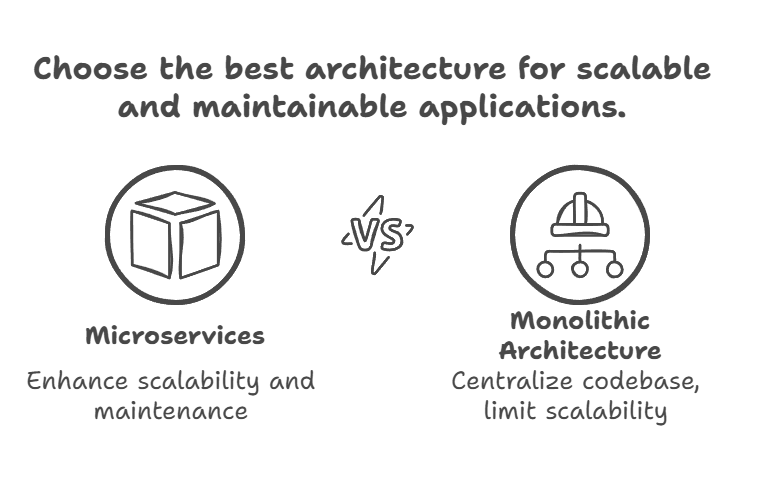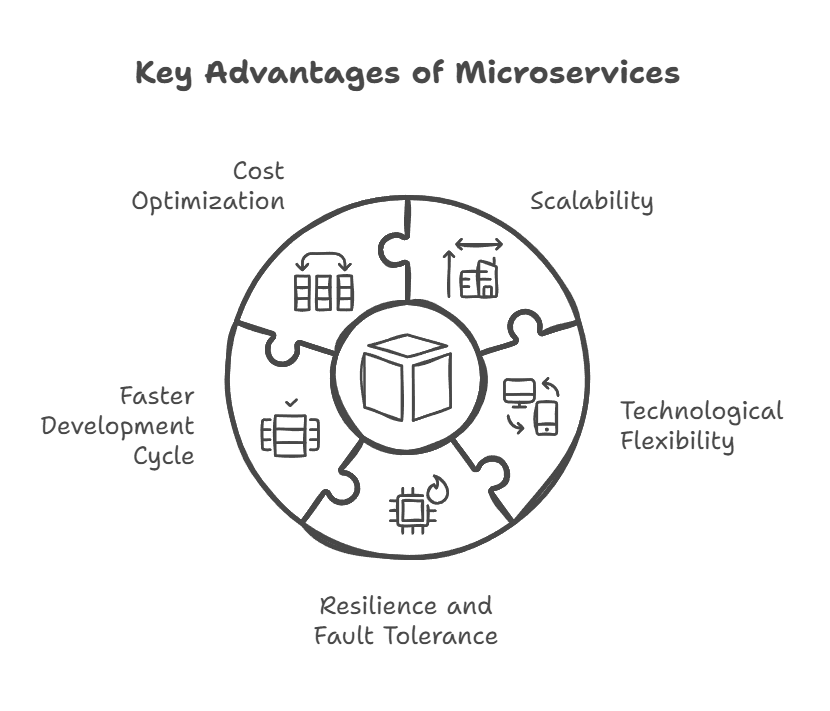

Microservices: How to implement them in your company
February 26, 2025
Table of contents
Quick Access
This article explores what microservices are, their benefits, use cases, key tools for their implementation, and the challenges that companies must consider to make the most of this technology.
In today's business world, technology plays a crucial role in competitiveness and operational efficiency. Companies that manage large-scale applications are constantly looking for ways to optimize their software architecture to improve scalability, resilience, and speed of delivery of digital products.
One of the most revolutionary approaches in recent years has been the adoption of microservices-based architectures. This methodology allows an application to be divided into small, independent services, each with a specific function, facilitating the development and scalability of complex software.
In 2025, microservices have evolved significantly, with new tools, best practices, and more widespread adoption across multiple industries.

What are microservices?
Microservices are a software development approach in which an application is broken down into multiple small, independent services that work together to form a functional system.
Difference from monolithic architecture
Traditionally, many companies have developed applications with a monolithic architecture, where all modules of an application are interconnected within a single code base. This creates problems with scalability, maintenance, and flexibility.
In contrast, microservices offer:
- Decoupling: Each service is independent and communicates with others through APIs.
- Scalability: Specific services can be scaled without affecting the entire system.
- Ease of maintenance: Teams can develop, test, and deploy services autonomously.
Key features
- Autonomy: Each microservice is a separate functional unit.
- Independent deployment: Changes to one microservice do not affect others.
- Use of different technologies: They can be developed in different languages and frameworks.
- Communication through APIs: Usually with REST, gRPC, or messaging like Kafka.

Microservices in 2025: Trends and evolution
The evolution of technology has driven the development of microservices towards new paradigms that optimize their performance and scalability.
Current trends
- Cloud-native and serverless: More and more companies are adopting cloud-native architectures and serverless services to improve efficiency.
- Edge computing: The distribution of microservices to edge computing allows for reduced latency in IoT and telecommunications systems.
- Automation with AI: Artificial Intelligence for monitoring optimization, load balancing and failure recovery.
It is estimated that by 2025, 80% of companies that develop large-scale applications will have adopted microservices-based architectures.
Benefits of implementing microservices in companies
Implementing microservices in a company brings key advantages:
Scalability
It allows individual components to be scaled according to demand, reducing costs and improving performance.
Greater technological flexibility
Different technologies and programming languages can be used depending on the needs of each service.
Greater resilience and fault tolerance
If a microservice fails, the rest of the system continues to function, avoiding a complete application crash.
Faster development cycle
Small teams can work in parallel on different microservices, speeding up delivery time.
Cost optimization
Specific resources can be scaled based on demand on cloud platforms such as AWS, Azure or Google Cloud.

Use cases: How microservices can be implemented in businesses
Below, we explore examples of how different industries have adopted microservices:
E-commerce (Example: Amazon)
- Separate services for payments, inventory management, product recommendation and shipping.
- Improves user experience and responsiveness during peak demand seasons.
Banking and Fintech (Example: Revolut)
- Implementation of separate services for authentication, payment processing and account management.
- Increases security and facilitates integration with external APIs.
Health and medical technology (Example: IBM Watson Health)
- Interoperability between patient management, billing and clinical data analysis systems.
Entertainment and streaming (Example: Netflix)
- Use of microservices to manage content playback, personalization of recommendations and user authentication.
Tools and technologies for implementing microservices
To implement a microservice-based architecture, specialized tools are required:
- Programming languages: Java (Spring Boot), Python (FastAPI), Go, Node.js.
- Orchestration and containers: Docker and Kubernetes for deployment management.
- Communication between microservices: REST, GraphQL, gRPC, Apache Kafka.
- Monitoring and observability: Prometheus, Grafana, ELK Stack, OpenTelemetry.
- Security and authentication: JWT, OAuth 2.0, Istio for service mesh.

Challenges and best practices in adopting microservices
Common challenges
- Complexity in orchestration: Requires advanced tools such as Kubernetes.
- Distributed data management: Difficulty in consistency between databases of multiple services.
- Increased latency in communication: Constant interactions between microservices can increase latency.
Best practices
- Define clear boundaries for each microservice.
- Implement an API Gateway to manage communication traffic.
- Adopt DevOps and CI/CD to automate deployments and testing.
- Use Service Mesh like Istio to manage communication between services.
Conclusion and next steps
Microservices have transformed the way companies develop and operate software. With benefits such as scalability, resilience and technological flexibility, this architecture is key for companies looking to innovate in the digital world.
However, its implementation requires planning, adequate tools and a gradual adoption strategy. Companies must assess their needs, train their teams and take advantage of cloud solutions to maximize the potential of microservices.
If you are considering migrating to a microservices architecture, the time to start is now. Having the support of experts in the implementation can make the difference in the success of your technological strategy.
We recommend you on video
Related Blogs
.jpg)
Top 5 Container Orchestration Tools

How to do dockerfile port mapping?

Docker: How to stop all containers

How to create a local Docker image

Jira Pricing Explained: Which Plan Is Right for You?
